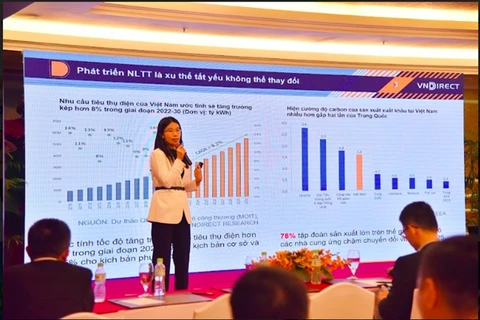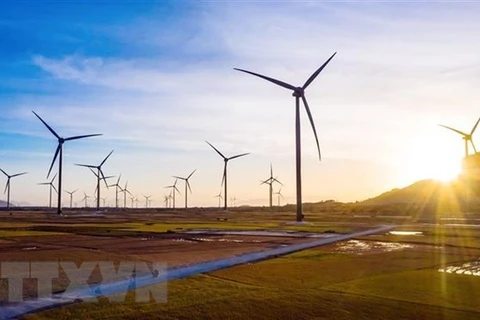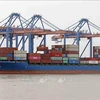Hanoi (VNA) - In a recently published article analysing the wind power potential of Vietnam, Nikkei Asia said Japanese and European corporations are making major moves into the offshore wind power in Vietnam, taking advantage of the developing country's renewable power push.
The country's commitment to fully decarbonise by midcentury, coupled with an urgent power generation deficit, make this an attractive time to invest in its renewable energy infrastructure.
Japan's Sumitomo Corp. announced the development of an offshore wind power generation project in September. That was followed by a survey in December to study routes for laying cables. The company plans to begin operations of a wind farm with a capacity of 500 MW to 1 GW by 2030.
If the initial plans get on track, the company aims to develop further projects, including in the northern part of the country.
Sumitomo has experience in developing offshore wind farms in Europe, including in Belgium and the UK. The output of the European plants, based on the investment ratio, is approximately 310 MW. That figure is expected to increase to about 600 MW when upcoming projects are included.
The company is considering partnerships with local companies to advance projects in Vietnam.
Sumitomo is not the only Japanese company looking for a piece of the country's offshore wind power market.
Renova, which specialises in renewable energy, has established a development base in Vietnam. In April, it signed a memorandum of understanding for offshore wind power development with Petrovietnam, with plans to develop a 2 GW power plant in the future. It is also considering developing a floating offshore power plant, in which turbines float on the ocean surface.
The company is involved in renewable energy projects in other countries such as the Republic of Korea and the Philippines, but it has dedicated the largest number of personnel to the project in Vietnam.
Renova has labelled the country as "one of the most important" for renewable energy development, according to Kei Saiki, co-head of the global business division.
Among European companies, Denmark's Orsted, the world's largest offshore wind power company, is leading the way.
The company began looking into a project in 2020 and signed a memorandum of understanding the next year with Vietnamese conglomerate T&T Group to develop a power plant.
T&T Group has already been expanding into renewable energy, with solar and onshore wind power plants generating 1 GW.
Orsted will incorporate T&T Group's know-how on renewable energy to further develop its projects. It plans to jointly begin operations with T&T at a power plant with a total output of 2 GW in 2030.
Vietnam's favourable winds are a main draw.
According to a map published by the World Bank Group and others, offshore wind power is generally considered viable for development at a speed of about 8 meters per second. In Southeast Asia, winds this strong blow in Vietnam and the Philippines, while winds around Malaysia and Indonesia are generally weaker.
There are areas off the southern coast of Vietnam where winds can exceed 10 meters per second.
Vietnam is seen as "one of the best places in Asia for offshore wind power," according to Sebastian Hald Buhl of Orsted.
With a population of approximately 100 million, Vietnam is experiencing rapid economic growth and an increasing concentration of foreign manufacturers. At the same time, the power generation infrastructure is not keeping up with development, which could lead to chronic power shortages in the near future. During a July heat wave last year, large-scale blackouts occurred in the areas surrounding the capital, Hanoi.
 Vietnam is assessed as one of the best places in Asia for offshore wind power. (Photo: TH/VietnamPlus) At the UN Climate Change Conference COP26 in Glasgow in 2021, Vietnamese Prime Minister Pham Minh Chinh announced plans to achieve net zero emissions by 2050. In the medium to long term, it will be necessary to secure energy sources to replace coal, which accounts for about 50% of all power generation in the country, reported Nikkei Asia.
Vietnam is assessed as one of the best places in Asia for offshore wind power. (Photo: TH/VietnamPlus) At the UN Climate Change Conference COP26 in Glasgow in 2021, Vietnamese Prime Minister Pham Minh Chinh announced plans to achieve net zero emissions by 2050. In the medium to long term, it will be necessary to secure energy sources to replace coal, which accounts for about 50% of all power generation in the country, reported Nikkei Asia.
Following incentives issued under the Prime Minister’s Decision No 39, the scale of wind power in Vietnam has surged by over 45 times, from 90 MW in 2017 to over 4,100 MW as of November 2021.
The draft National Power Development Plan VIII also gives priority to the development of onshore and offshore wind power. Onshore wind power is expected to reach 21,480 MW and offshore one 7,000 MW, including 4,000 MW in the north, by 2030./.
The country's commitment to fully decarbonise by midcentury, coupled with an urgent power generation deficit, make this an attractive time to invest in its renewable energy infrastructure.
Japan's Sumitomo Corp. announced the development of an offshore wind power generation project in September. That was followed by a survey in December to study routes for laying cables. The company plans to begin operations of a wind farm with a capacity of 500 MW to 1 GW by 2030.
If the initial plans get on track, the company aims to develop further projects, including in the northern part of the country.
Sumitomo has experience in developing offshore wind farms in Europe, including in Belgium and the UK. The output of the European plants, based on the investment ratio, is approximately 310 MW. That figure is expected to increase to about 600 MW when upcoming projects are included.
The company is considering partnerships with local companies to advance projects in Vietnam.
Sumitomo is not the only Japanese company looking for a piece of the country's offshore wind power market.
Renova, which specialises in renewable energy, has established a development base in Vietnam. In April, it signed a memorandum of understanding for offshore wind power development with Petrovietnam, with plans to develop a 2 GW power plant in the future. It is also considering developing a floating offshore power plant, in which turbines float on the ocean surface.
The company is involved in renewable energy projects in other countries such as the Republic of Korea and the Philippines, but it has dedicated the largest number of personnel to the project in Vietnam.
Renova has labelled the country as "one of the most important" for renewable energy development, according to Kei Saiki, co-head of the global business division.
Among European companies, Denmark's Orsted, the world's largest offshore wind power company, is leading the way.
The company began looking into a project in 2020 and signed a memorandum of understanding the next year with Vietnamese conglomerate T&T Group to develop a power plant.
T&T Group has already been expanding into renewable energy, with solar and onshore wind power plants generating 1 GW.
Orsted will incorporate T&T Group's know-how on renewable energy to further develop its projects. It plans to jointly begin operations with T&T at a power plant with a total output of 2 GW in 2030.
Vietnam's favourable winds are a main draw.
According to a map published by the World Bank Group and others, offshore wind power is generally considered viable for development at a speed of about 8 meters per second. In Southeast Asia, winds this strong blow in Vietnam and the Philippines, while winds around Malaysia and Indonesia are generally weaker.
There are areas off the southern coast of Vietnam where winds can exceed 10 meters per second.
Vietnam is seen as "one of the best places in Asia for offshore wind power," according to Sebastian Hald Buhl of Orsted.
With a population of approximately 100 million, Vietnam is experiencing rapid economic growth and an increasing concentration of foreign manufacturers. At the same time, the power generation infrastructure is not keeping up with development, which could lead to chronic power shortages in the near future. During a July heat wave last year, large-scale blackouts occurred in the areas surrounding the capital, Hanoi.
 Vietnam is assessed as one of the best places in Asia for offshore wind power. (Photo: TH/VietnamPlus)
Vietnam is assessed as one of the best places in Asia for offshore wind power. (Photo: TH/VietnamPlus) Following incentives issued under the Prime Minister’s Decision No 39, the scale of wind power in Vietnam has surged by over 45 times, from 90 MW in 2017 to over 4,100 MW as of November 2021.
The draft National Power Development Plan VIII also gives priority to the development of onshore and offshore wind power. Onshore wind power is expected to reach 21,480 MW and offshore one 7,000 MW, including 4,000 MW in the north, by 2030./.
VNA


























